[Here’s a link to other forays around my map.]
“There is in fact a sort of harmony discoverable between the capabilities of the landscape within a circle of ten miles’ radius, or the limits of an afternoon walk, and the threescore years and ten of human life. It will never become quite familiar to you.” – Thoreau
I was looking forward to this one. Or at least I was once I gritted my teeth and stepped out into the cold, grey January drizzle and began riding towards today’s grid square. ‘Tis always the way. Today’s square promised lakes, fields, and a small community bordered by a railway line and a river. Of all these, I was looking forward mostly to the river. The map that I live on has very few rivers. This is something that I regret weekly, at least.
But my initial attempts to get to the river were foiled by high hedges, private property signs, and a high spiked fence. The lakes were fenced off as fiercely as a prison. Old flooded gravel quarries, they are now private fishing lakes, spread tantalisingly over four grid squares. As best as I could make out through the chainlink fencing, they looked lovely and restful. Here and there a few men sat hunched beneath enormous green umbrellas, surrounded by a surprising paraphernalia of gear to try to outwit the lakes’ carp, perch, chub, tench, roach, bream, eels, and dace.
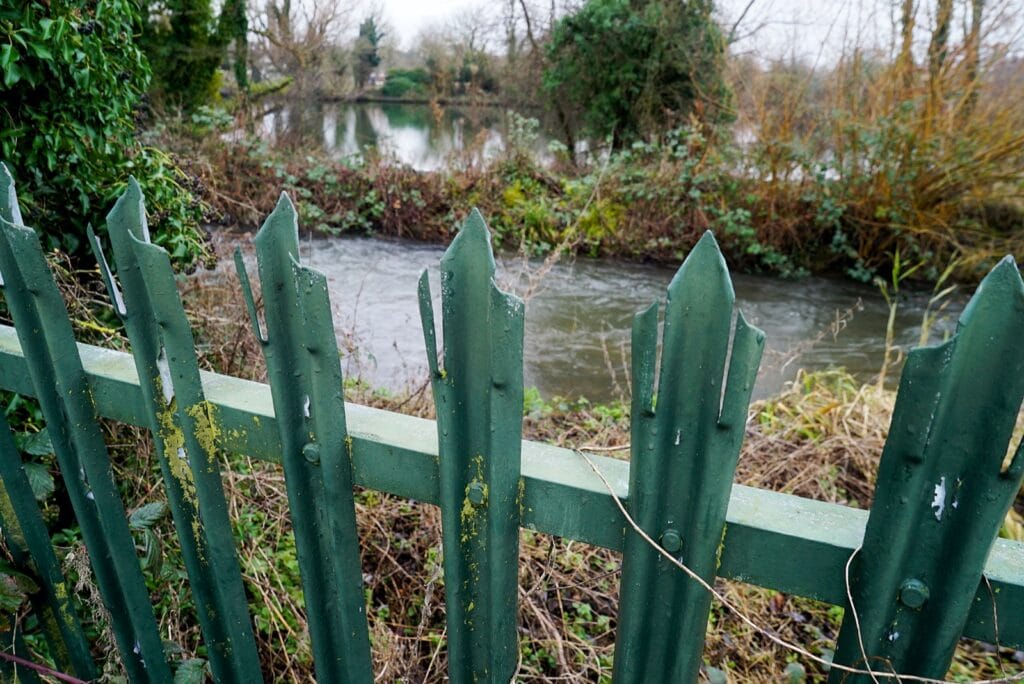

I met a fisherman who was leaving for the day. He carefully locked the tall gate behind him after pushing out his wheelbarrow of kit. I asked if the occasional loud bangs I heard were aimed to scare away herons.
“Cormorants,” he answered. “Horrible things. They’ve moved in from the sea. We had 80 of them on the lake once. They’ll go for anything, even fish too big for them to eat.”
Cormorants can grow up to a metre long and are about the size of a goose, with a maximum lifespan of 23 years. They are distinguished by their habit of standing on sandbars or logs with the wings outstretched. Although they are regarded as seabirds, they are now commonplace around inland fisheries and waterways, where they fish for dace and trout.
Martin Salter MP, the Government’s official adviser on angling and shooting, said the “cormorant is a lethal killing machine” and a widespread cull was now necessary.
“They can eat up to 2lbs of fish a day which means they take up to 30,000 tons of fish a year. Whole fisheries could be cleaned out of stock,” he said. “It is all very well for the RSPB to complain about a cull but they were all in favour of culling ruddy ducks when they thought they were breeding with the [endangered] white-headed duck.”
All of which only made my head spin. What is the best way to ‘control’ nature? Do we heed the bird lovers or the fish lovers? A damp January afternoon was not conducive to my brain answering such questions. The only clear fact was that whenever humans get involved, nature gets messed around.
I moved on from cormorants to ask about the lakes. “I’d love to go and explore them, but why are they all fenced off?”
“I don’t like the fencing,” sympathised the fisherman. “But it’s necessary, sadly. Sometimes I love to just go for an evening walk round the lakes. Not even bring a rod. Just enjoy it. They all used to be open but it was chaos. Dog walkers and anglers don’t really get on. Dog muck. Dogs running around, their noses in the bait boxes. Jumping in the water. Dogs getting hooked in the mouth. Chaos. But it was still all open until, oh, less than 20 years ago. I’m not racist, but….”
My ears pricked up. Here we go, I thought. What on earth does fishing have to do with race?
“But it was poaching that did it. When all the Polish people come here about 20 years ago. Nice people, don’t get me wrong. But they eat carp. Christmas dinner in Poland is carp. [A traditional Wigilia supper in Poland includes fried carp and borscht (beetroot soup) with uszka (ravioli). Carp provides a main component of the Christmas Eve meal across Poland; carp fillet, carp in aspic and gefilte fish.]”
“You seem them all down in the town, catching carp under the bridge, slipping them into their bags. Our lakes were getting ruined by poaching. So we had to put up all these fences.”
All of which only made my head spin. A damp January afternoon was not conducive to my brain resolving the rub of different cultures meeting and mixing and disagreeing. The Daily Mail, inevitably, gets red-faced and angry about this weird intersection of recreational fishing and immigration angst that I’d stumbled upon. More positive is the story of Radoslaw Papiewski whose vision to educate migrant anglers on England’s fishing laws led to the creation of the hugely successful Building Bridges project. The team have helped integrate thousands of Eastern European anglers into angling clubs, run ‘fishing schools’ for children, produced multi-lingual posters and signs, and organised fishing contests bringing together anglers from different countries and cultures.
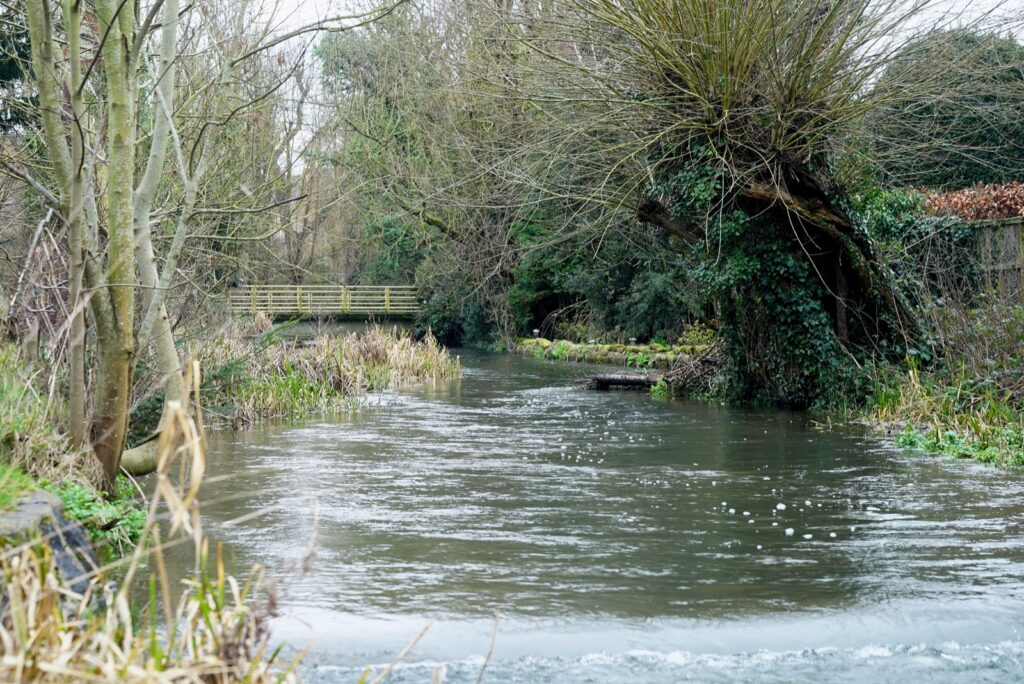
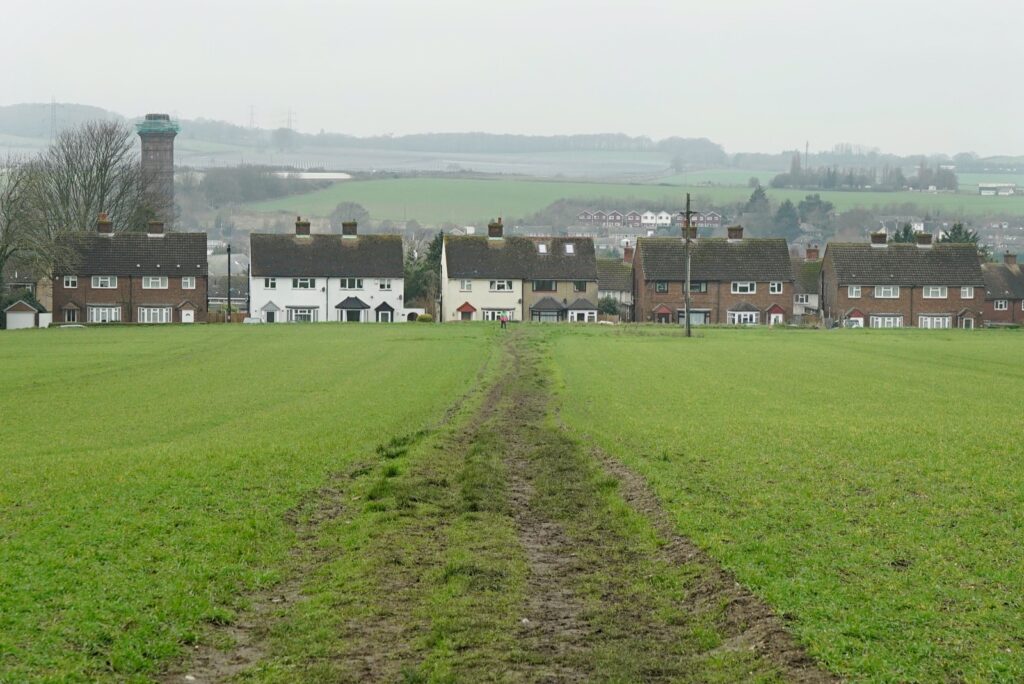
The most interesting thing my new fisherman friend said was something that has been very apparent to me throughout my attempt to explore a single map. “If you want the real problem though, you’ve got to blame the Enclosures Act of 200 years ago.”
The Enclosure Acts cover enclosure of open fields and common land in England and Wales, creating legal property rights to land previously held in common. Between 1604 and 1914, over 5,200 individual enclosure acts were passed, affecting 6.8 million acres.
With legal control of the land, landlords introduced innovations in methods of crop production, increasing profits and supporting the Agricultural Revolution; higher productivity also enabled landowners to justify higher rents for the people working the land.
A poem from the 18th century reads as a protest of the inclosure acts:
They hang the man and flog the woman
Who steals the goose from off the common
Yet let the greater villain loose
That steals the common from the goose
For centuries, English agriculture depended on common land –land that was privately owned but to which others enjoyed the legal right of access (the term “commoner” originally meant someone who had access to common land). Waste land was also accessible to local inhabitants. It was universally understood that common and waste land were to be used for planting crops, grazing livestock, gleaning, foraging, and sometimes hunting and fishing; they also provided wood and turf that could be used as fuel. Though small-scale agriculture could be arduous and unpredictable, life organised around the commons was relatively democratic, egalitarian, and self-sustaining, especially compared to the urban life that succeeded it.
Not only did the Enclosure Acts contribute to an economic crisis, they also redefined the land and its relationship to the people. The image of a happy, prosperous village was an idealised vision of England itself, in which “the people” were industrious, independent farmers with ties to specific plots of land going back through generations. With the rise of large-scale agriculture and the removal of small farmers from land that had historically been theirs to use, this image became increasingly difficult to sustain.
Over the course of a few hundred years, much of Britain’s land has been privatised. Currently, in our “property-owning democracy”, nearly half the country is owned by 40,000 land millionaires, or 0.06 per cent of the population.
And so little old me finds myself peering over a fence at the stream I’d like to paddle in. I settle for enjoying the sound of running water and watch a cloud of flies dancing around like nocturnal will’o-the-wisps. Winter gnats or winter craneflies are the long legged, swarm forming, flies of the cold.
This is a small family, formally called Trichoceridae, with only 10 species occurring in the UK from just two genera. However this maybe set to change. A new publication is imminent on British craneflies that will include this family and there is thought that maybe there is up to 14 species. Even in the UK there are species still to be described or reassessed and new discoveries to be had.
They very much resemble delicate craneflies, but these species have the advantage of having ocelli. These are the very small simple ‘eyes’ (ocelli means simple eyes) on the apex of the head that very sensitive to light, presumably being very helpful in the dark days of winter.
We notice this species a lot around this time of year because of their swarming behaviour, dancing together, often late in the afternoon when the sun is setting. Trichocera annulata, as with all of the species, swarms consist mostly of males; easily recognisable by a pair of forceps at the end of the abdomen – all the better for grabbing onto the female – whereas she has a tapered abdomen with a rather splendid curved ovipositor (her egg laying tube). The adults can be short lived – some adults have been noted to live only five days – that’s a lot of pressure on them to find a mate and produce offspring!
I cycled past Roman Villa Road (2000 years of history in one overgrown road sign) and past a modern Catholic church (whose footing in England began in the year 596 with Pope Gregory the Great’s mission to convert us unruly Anglo Saxons, has eventually led to Boris Johnson becoming the first baptised Catholic to become prime minister, and -since 2015- now allows members of the Royal Family to marry a Roman Catholic and become king or queen. However, a Roman Catholic royal still cannot become the monarch.) The church had a statue of a very bored-looking St George spearing the dragon through its mouth with minimal effort.
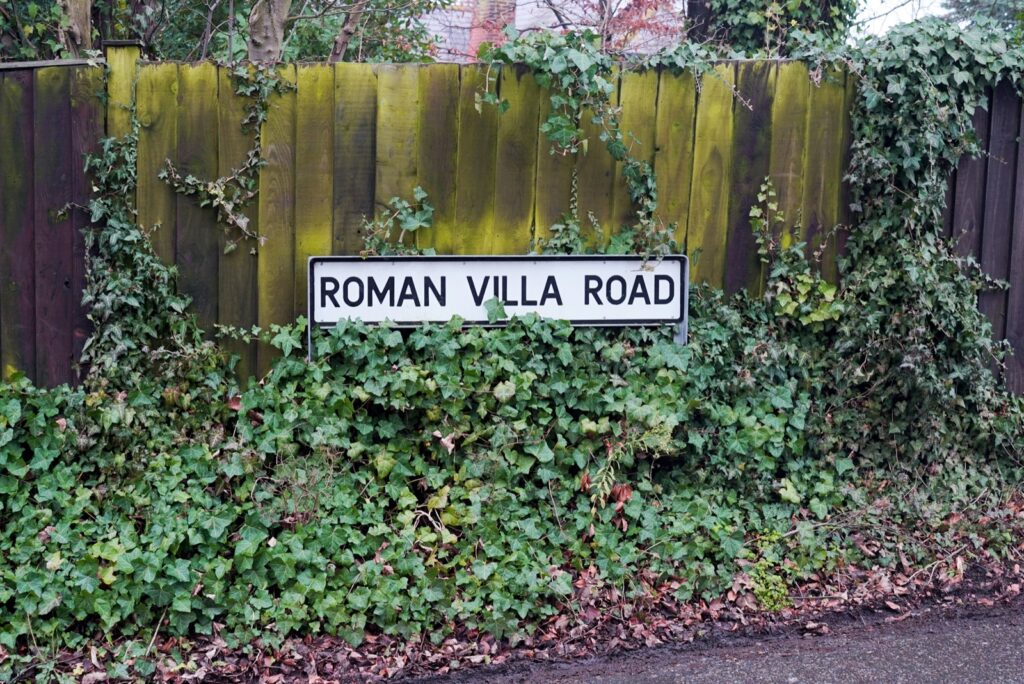

Old George had quite the journey to make it from his beginnings as a soldier in the Roman Army to the patron saint of not only England, but also Georgia, Ethiopia, Catalonia, Aragon, Valencia, and Corinthians FC in Sao Paolo.
I also passed a garden with two full size sculptures of giraffes standing tall outside a blue garden shed.

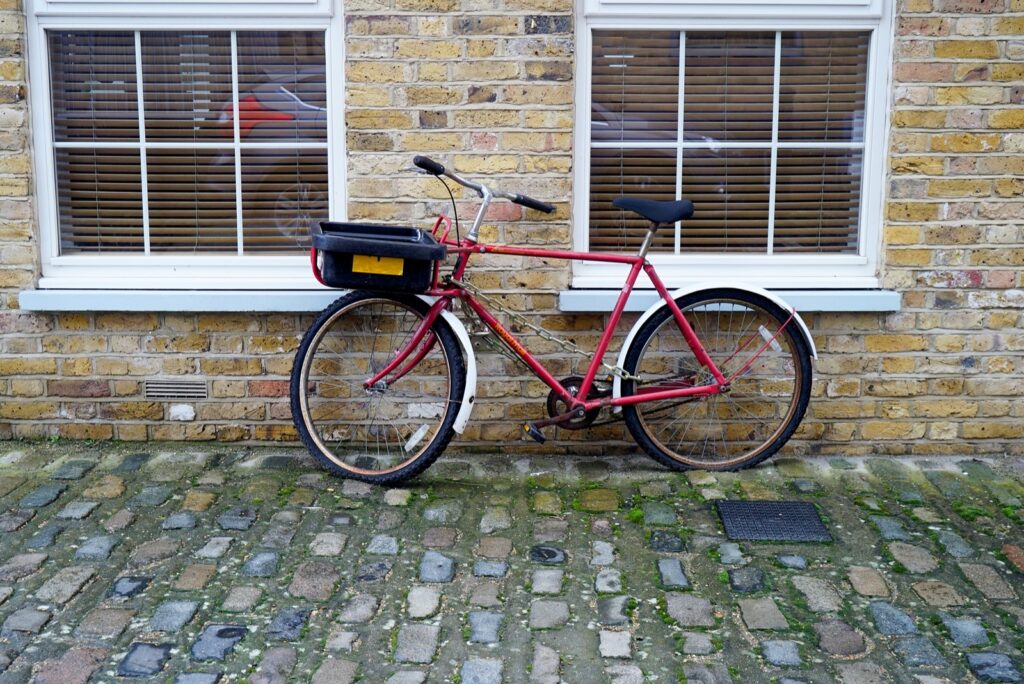
Then I rode into a maze of council estates, many of whose homes looked run down and unloved. But the name of one house –’Cosy Nook’– caught my eye and reminded me that home and belonging and happiness depend in no small part upon the attitudes you choose to live by. In the window of another house I spot a dozen shining trophies in an upstairs window. A child’s bedroom, I guess, and a kid rightly proud of their efforts and achievement.
My bike and I slithered across a soggy field, empty save for a lone wonky football goal minus its net. Later I saw a solitary swing, missing its seat and chain and therefore its entire swing. Recreation fared better elsewhere, with a local bowls club (car park sign donated ‘in memory of Alan’), a football ground whose sheltered viewing area was perked up with swathes of bright, skilful graffiti.
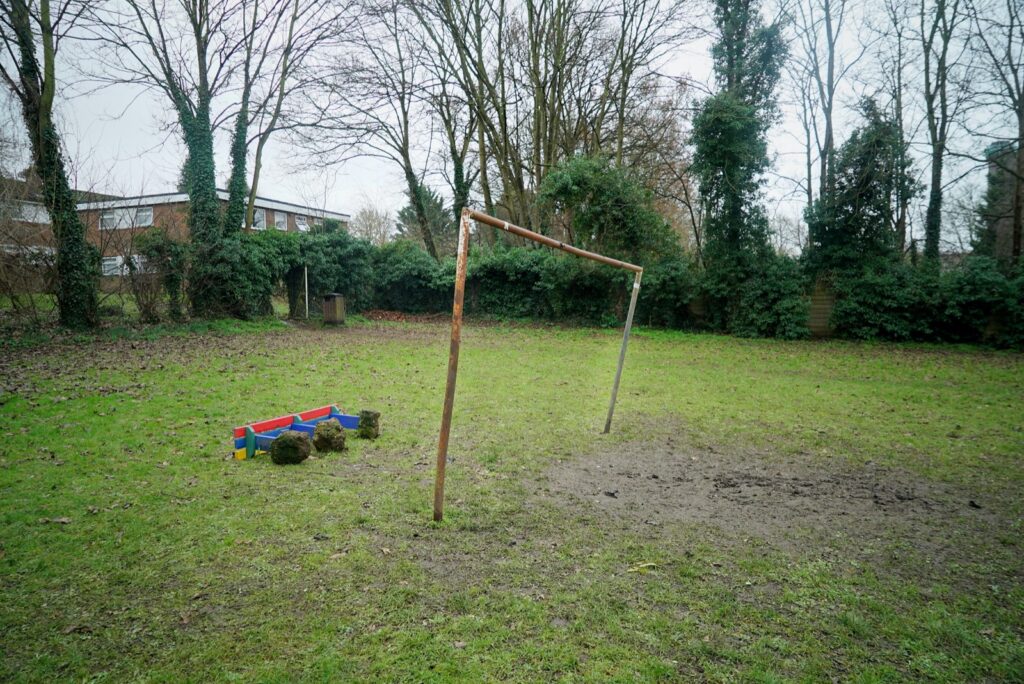

Some young scally had forgotten to take their bag of fizzy drinks and Jammie Dodger biscuits (named after Roger the Dodger from the Beano comic) home with them. I was tempted to nick his snacks but instead had a play on the outdoor gym equipment that had been installed. A noble idea, of course, but I have never seen these installations used in anger, anywhere, by anyone. Typically, there’ll be a cross-trainer, a shoulder press, a lat pull-down machine, and mine has a leg extender. There’s rarely anything for your abs, as nothing beats the plank, which requires only character. You cannot alter the weight or the resistance on the cross-trainer. And in truly democratic style, they’re all set at pretty low loads. On the cross-trainer, I’m simply swinging my legs backwards and forwards; it’s like relearning how to walk during convalescence. This is not to say these are pointless; they’re great for flexibility, and a good way-point in a longer, mainly cardio workout. I’m being boosterish because it’s nice to show appreciation when the council erects a brightly coloured thing.
Type two [of outdoor gym], meanwhile, is lower tech (almost all wood, the odd bit of pipe) but much more useful. They’re designed along calisthenic lines – for you to use your own body weight against yourself. Tricep dips and push-ups on the low beam are particularly satisfying – all the joy of exercising outdoors, but none of the mud all over yourself. The pull-ups are too macho for my blood.
Talking of the masculinist sensibility, there is a military convention of the pyramid workout, which is much easier to stick to when there’s equipment to suggest a basic set of activities: run 25 metres, do two push-ups, run another 24, do four, run another 25, do eight, and so on. Otherwise you’re left having to do burpees and bear crawls in front of people who are innocently walking their dogs, which is embarrassing for everyone, even the dog.


Overshadowing many of the streets in my grid square, quite literally, was an enormous railway embankment. It leads on to an impressive viaduct, visible for miles around. The ten arches, ten metres wide and 20 metres high, were impressive. I have seen it in the distance from several of the other grid squares I have explored. I notice already that I am understanding the lie of the land better and how all these different places fit together.
Passing beneath it I turned off the road onto a footpath and found that I could get close to the river at last. It was swollen and swift and turbid. Although the day was cold and damp there was a hint of spring to it. There seemed to be more birdsong than last week. Wrens bustled around the base of hedges. Shoots of daffodils were beginning to push through the wet ground. My bike clogged with mud as I slipped and slid along the riverbank.
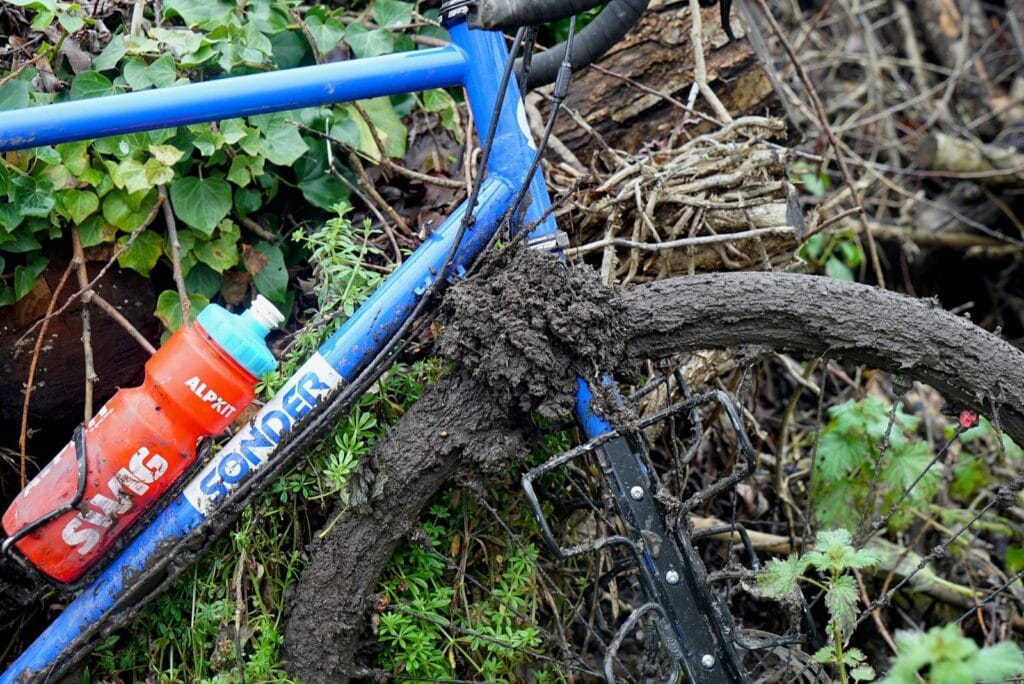
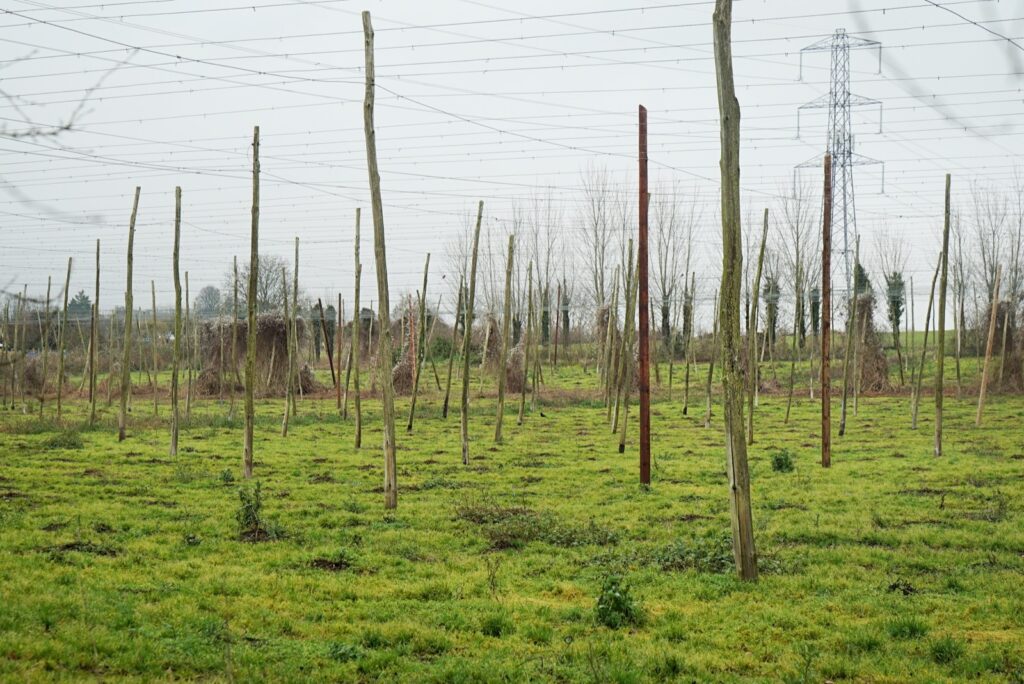
A row of terrace homes, built (I imagine) along with the railway viaduct and station 160 years ago, had strangely long, narrow gardens, reaching out like tendrils to grant them access to the river bank and enough space for summer decking and barbecues by the stream. The neighbouring fields had been ploughed a deep, dark colour of earth, sprinkled with white flint. Hop poles stood tall like washing lines across other fields. In the summer they will be a bright green, hung with the spindly plants so key to beer-making. Returning to my bike after taking a few photos, I was delighted to find that a feisty robin was perched on my handlebars, singing lustily. I waited patiently for it to depart then schlepped on through the mud.
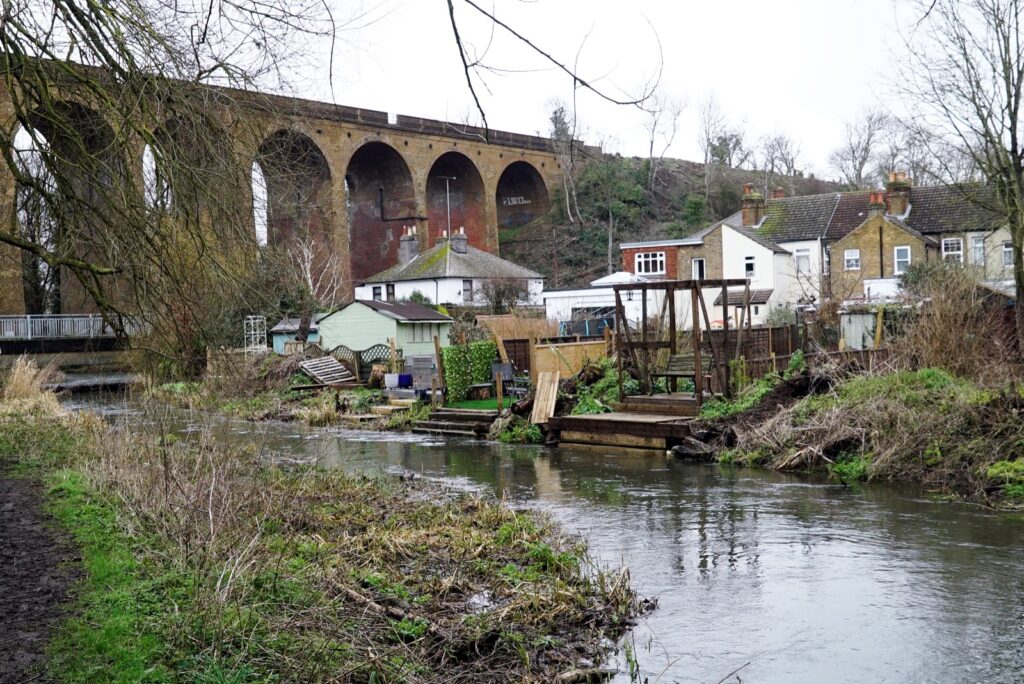
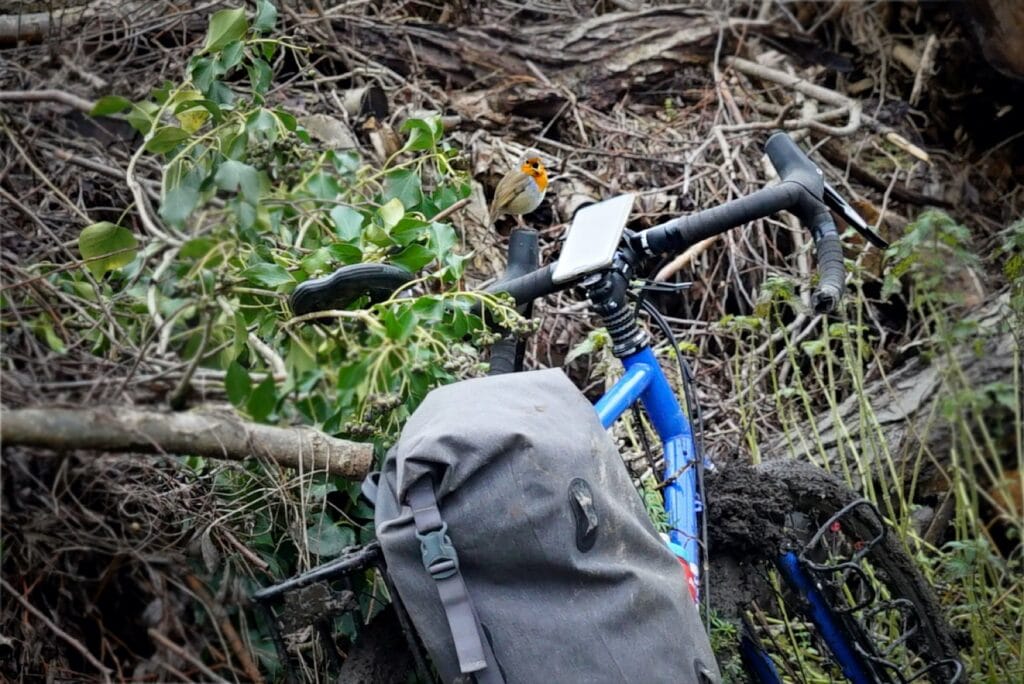
This busy, bubbling stream accounts indirectly for the entire community built here. One small community with a retirement community, millennials in mill apartments, doughty terraces, cheaply-built council houses, and a sprinkling of smart old detached homes behind beech hedges. The river’s water powered small flour mills, whose trade also kept a forge in business. In the 19th Century a paper mill was built, its tall stone chimney towering over the village like the viaduct. I was struck not only by how imposing it must have looked when it was built, what an astonishing energy there was in the country back then, but also how quickly things come and go, in the grand scheme of things.

Today the mill buildings are all neat commuter apartments, centred around a Co-Op with a one-in-one-out Covid rule and a whiff of weed coming from a second floor flat on Esparto Way. Esparto grass is known for its use in papermaking. The fiber makes a high quality paper often used in book manufacturing. First used in Great Britain in 1850, it is endemic to the Western Mediterranean (growing in Portugal, Spain, Morocco, Algeria, Tunisia and Libya). “Esparto” or σπάρτο in Greek may refer to any woven products of sedge or broom, including cords and ropes. This species grows forming a steppic landscape – esparto grasslands – which covers large parts of Spain and Algeria. From the Romans to the Victorians to whatever we’ll become known as, socially distancing on our phones as we wait in face masks for our turn to get out of the drizzle and into the shop to buy something for tea.

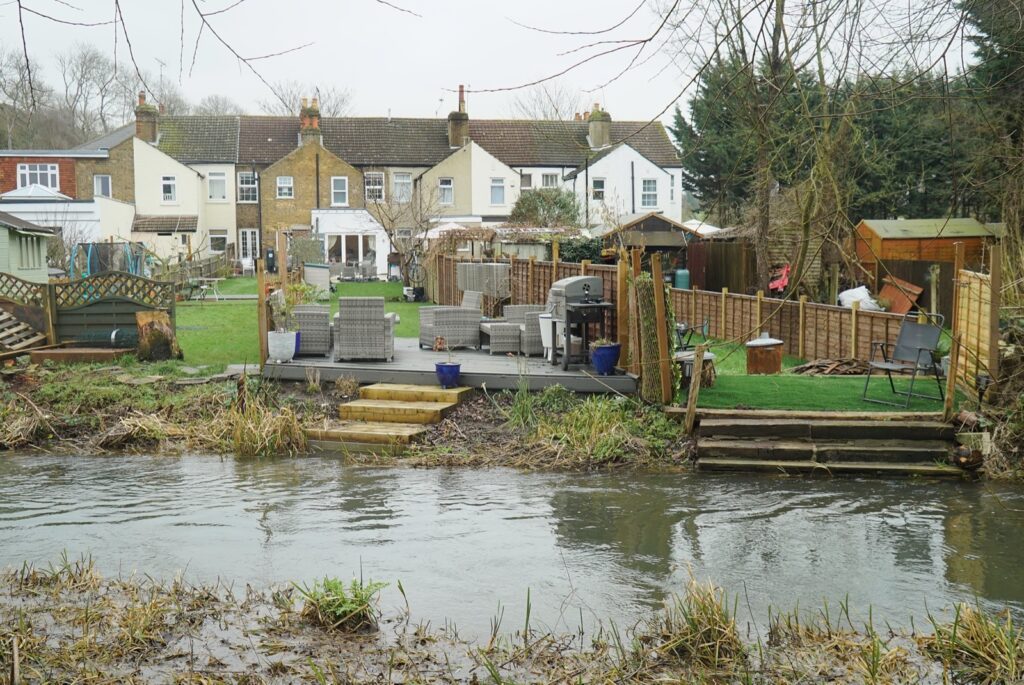
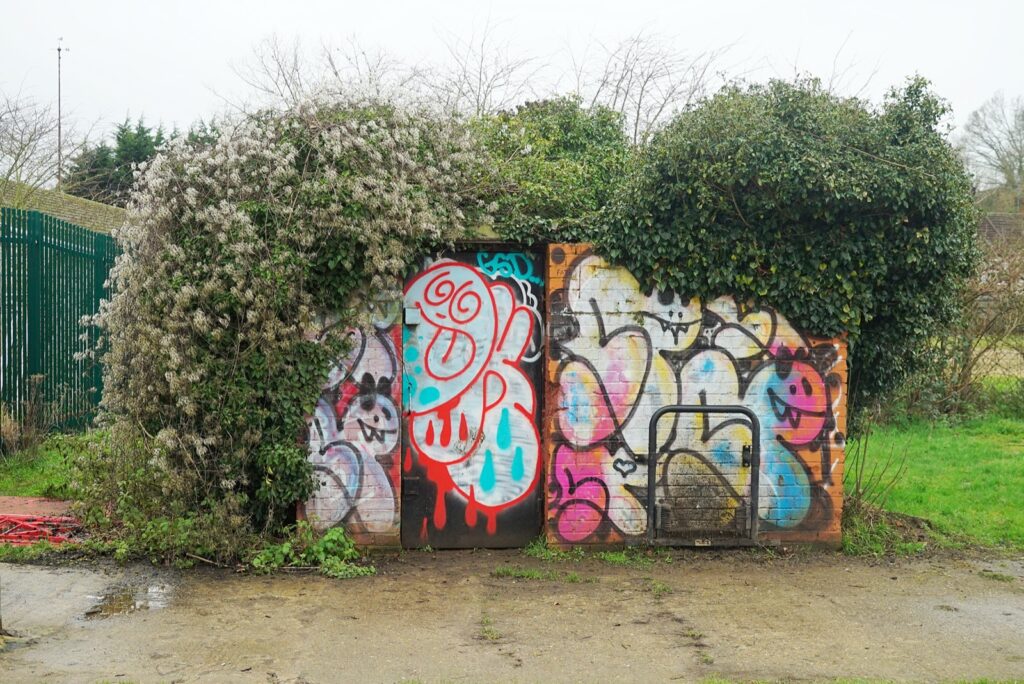




Another great write up thanks Al. Made me chuckle: “I was tempted to nick his snacks.”